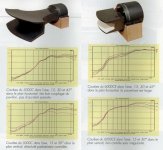Less well known outside the EU are the IWATA variations developed by Jean-Francois Guigue.
...
Nice, but I was never fully convinced by their brutally "cut" sides... surely such a drastic mutilation must affect performance?
Joseph Crowe's ES-290 Zebra Horn:
An externally hosted image should be here but it was not working when we last tested it.
VERY nice indeed!
Hello ,Yes, these were made by Franck Delbauve (I believe he lives in Belgium).
The mouth is 1.2m² (1.10 * 1.10), similar depth; 1.12m to the driver's exit, with a round adapter. Cut off is 150Hz, but could be lowered by using a longer throat adapter.
If you search "Delbauve Pavillon melaudia.net", you'll find lots of info in French, so you might want to use google tanslate.
The same guy also made the wooden JMLC-IWATA horns for the European Triode Festival 2013.
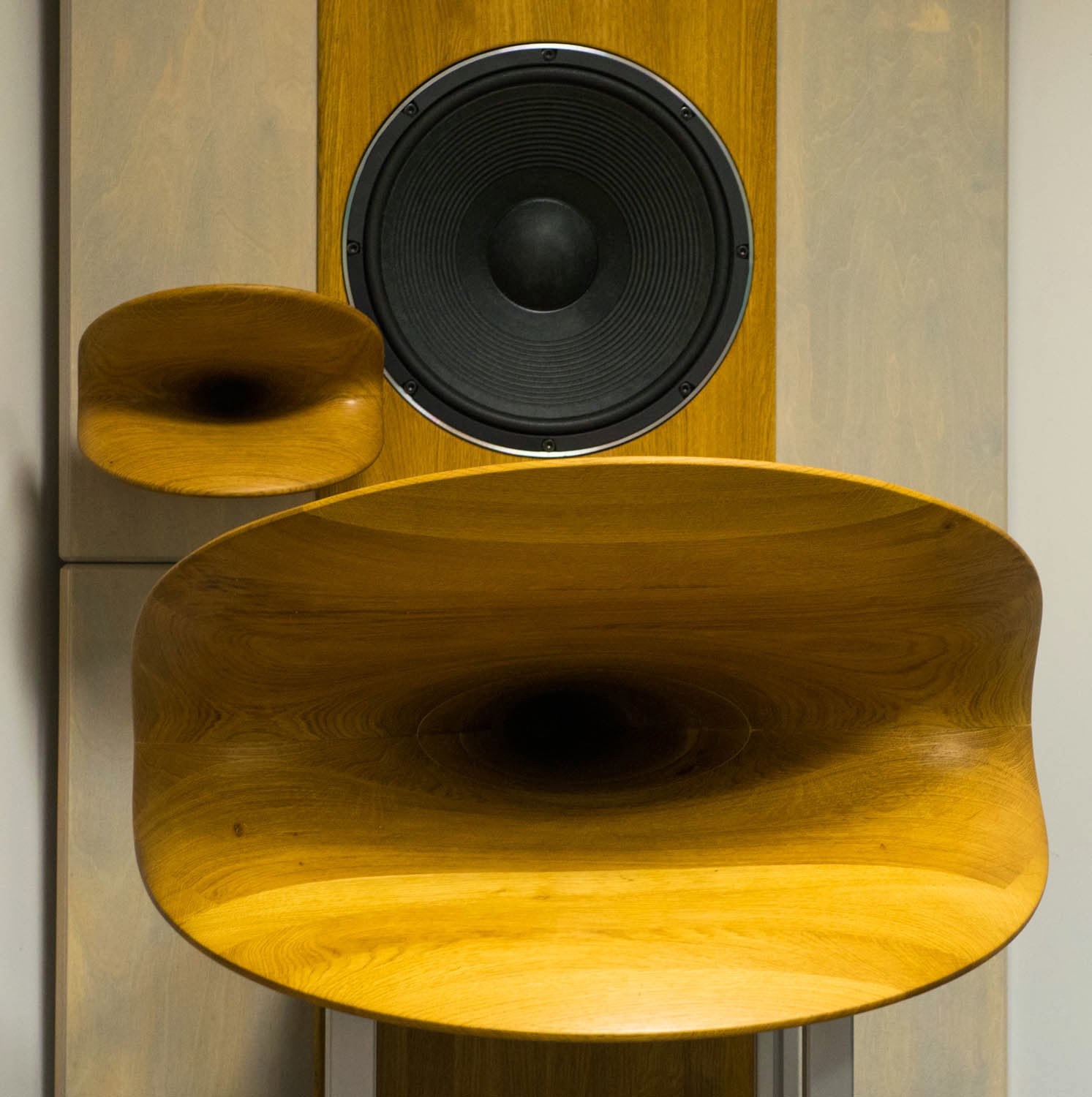
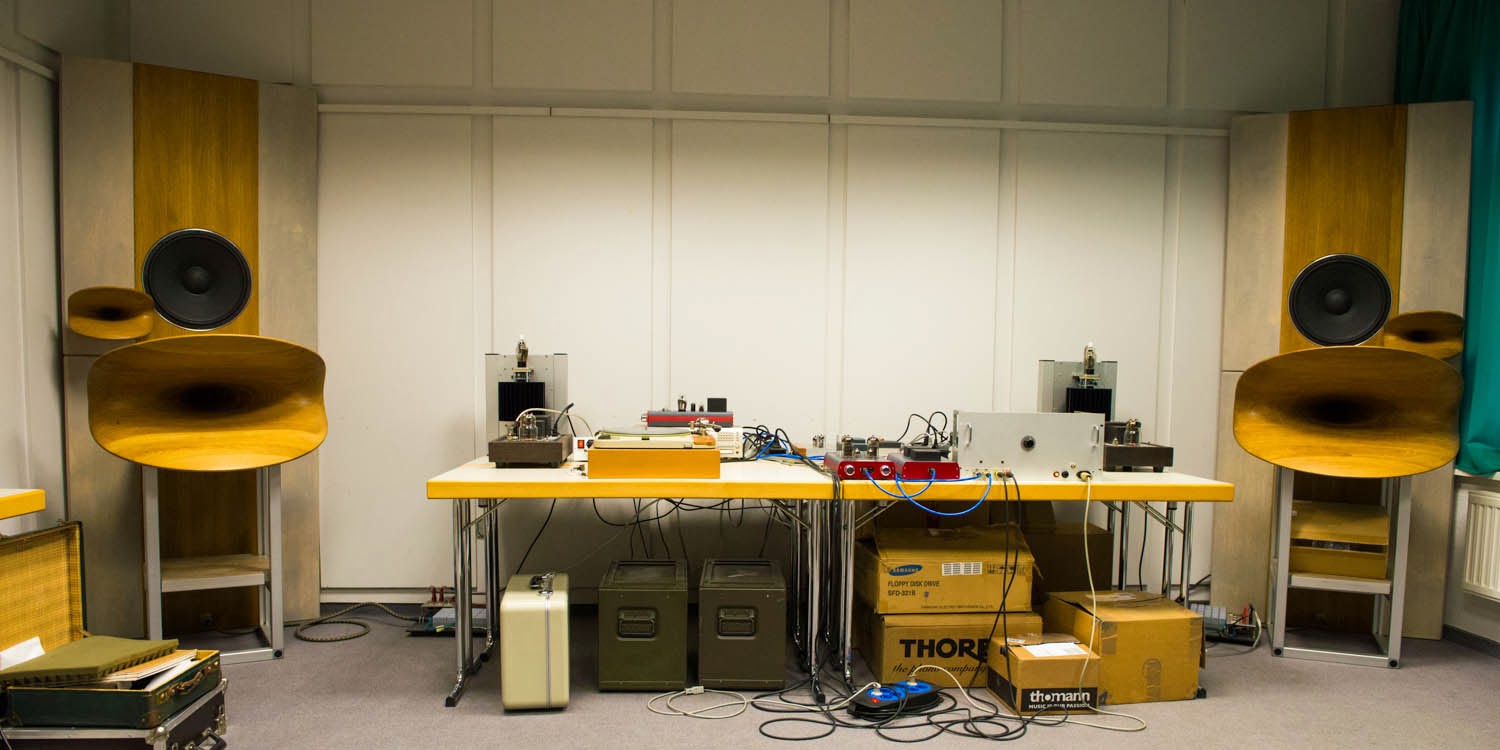

I am in France
Franck
Nice, but I was never fully convinced by their brutally "cut" sides... surely such a drastic mutilation must affect performance?
The side walls open faster > improved horizontal coverage.
Extended loading is provided by the top/bottom walls.
Especially in the vertical plane the Guigue horns are pretty much CD.
Attachments
Last edited:
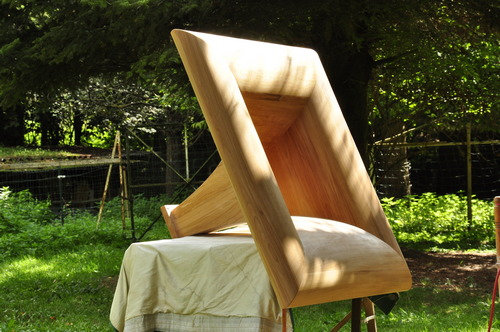
Hello ,
I am in France
Franck
Hello Franck !
beautiful work
mark
drba_swh_147_T07_Jericho - revisited
A few posts back there was a "jericho" horn provided by @docali that loaded very low but had a few issues. Speculation was it might be possible to "clean up" some of the diffraction and impedance issues.
These are the simulation results for that horn before modifications. The green surface is provided as the inner horn surface and will be identical in both.
A few posts back there was a "jericho" horn provided by @docali that loaded very low but had a few issues. Speculation was it might be possible to "clean up" some of the diffraction and impedance issues.
These are the simulation results for that horn before modifications. The green surface is provided as the inner horn surface and will be identical in both.
Attachments
-
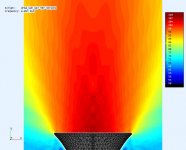 drba_swh_147_T07_Jericho-Hfield@6KHz.jpg37.6 KB · Views: 68
drba_swh_147_T07_Jericho-Hfield@6KHz.jpg37.6 KB · Views: 68 -
 drba_swh_147_T07_Jericho-Hfield@3K5Hz.jpg36.1 KB · Views: 67
drba_swh_147_T07_Jericho-Hfield@3K5Hz.jpg36.1 KB · Views: 67 -
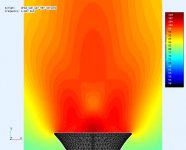 drba_swh_147_T07_Jericho-Hfield@1K5Hz.jpg35.1 KB · Views: 71
drba_swh_147_T07_Jericho-Hfield@1K5Hz.jpg35.1 KB · Views: 71 -
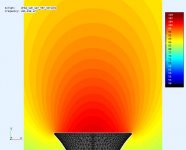 drba_swh_147_T07_Jericho-Hfield@500Hz.jpg33.5 KB · Views: 69
drba_swh_147_T07_Jericho-Hfield@500Hz.jpg33.5 KB · Views: 69 -
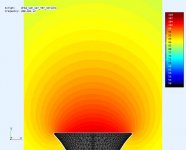 drba_swh_147_T07_Jericho-Hfield@200Hz.jpg32.4 KB · Views: 89
drba_swh_147_T07_Jericho-Hfield@200Hz.jpg32.4 KB · Views: 89 -
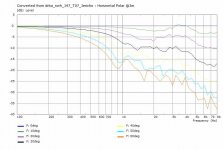 drba_swh_147_T07_Jericho-HorzPolarCurves.jpg42.8 KB · Views: 93
drba_swh_147_T07_Jericho-HorzPolarCurves.jpg42.8 KB · Views: 93 -
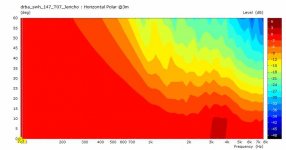 drba_swh_147_T07_Jericho-HorzPolarCont.jpg25.4 KB · Views: 84
drba_swh_147_T07_Jericho-HorzPolarCont.jpg25.4 KB · Views: 84 -
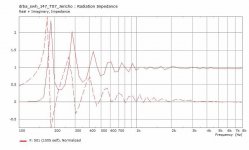 drba_swh_147_T07_Jericho-RadImp.jpg37.4 KB · Views: 88
drba_swh_147_T07_Jericho-RadImp.jpg37.4 KB · Views: 88 -
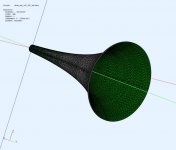 drba_swh_147_T07_Jericho-3Dview.jpg83.3 KB · Views: 100
drba_swh_147_T07_Jericho-3Dview.jpg83.3 KB · Views: 100
Last edited:
drba_swh_147_T07_Jericho - modified
This is "jericho" after some modifications.
The green surface is exactly the same as before. The teal surface is an additional curve#1 to take the mouth exit from 45deg to 90deg. The grey continuation is curve #2 to create the roll over. The same scale is used in the pre/post graphs.
Making the mouth larger improves the impedance match and the round over reduces the diffraction.
This is "jericho" after some modifications.
The green surface is exactly the same as before. The teal surface is an additional curve#1 to take the mouth exit from 45deg to 90deg. The grey continuation is curve #2 to create the roll over. The same scale is used in the pre/post graphs.
Making the mouth larger improves the impedance match and the round over reduces the diffraction.
Attachments
-
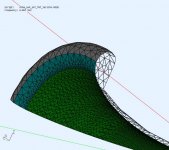 drba_swh_147_T07_Jericho_RO2b-Xsection.jpg66.6 KB · Views: 99
drba_swh_147_T07_Jericho_RO2b-Xsection.jpg66.6 KB · Views: 99 -
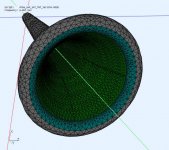 drba_swh_147_T07_Jericho_ROb2-3Dview.jpg86.7 KB · Views: 105
drba_swh_147_T07_Jericho_ROb2-3Dview.jpg86.7 KB · Views: 105 -
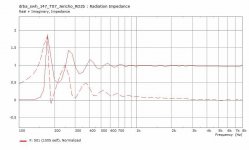 drba_swh_147_T07_Jericho-RO2b-RadImp.jpg35.5 KB · Views: 110
drba_swh_147_T07_Jericho-RO2b-RadImp.jpg35.5 KB · Views: 110 -
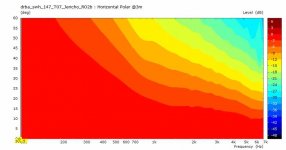 drba_swh_147_T07_Jericho_RO2b-HorzPolarCont.jpg24.2 KB · Views: 99
drba_swh_147_T07_Jericho_RO2b-HorzPolarCont.jpg24.2 KB · Views: 99 -
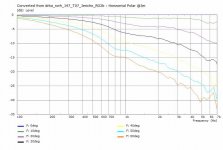 drba_swh_147_T07_Jericho_RO2b-HorzPolarCurves.jpg40.4 KB · Views: 107
drba_swh_147_T07_Jericho_RO2b-HorzPolarCurves.jpg40.4 KB · Views: 107 -
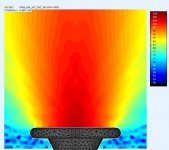 drba_swh_147_T07_Jericho_RO2b-Hfield@6KHz.jpg47.4 KB · Views: 74
drba_swh_147_T07_Jericho_RO2b-Hfield@6KHz.jpg47.4 KB · Views: 74 -
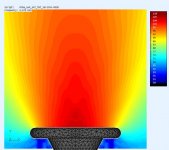 drba_swh_147_T07_Jericho_RO2b-Hfield@3K5Hz.jpg43.9 KB · Views: 82
drba_swh_147_T07_Jericho_RO2b-Hfield@3K5Hz.jpg43.9 KB · Views: 82 -
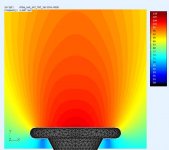 drba_swh_147_T07_Jericho_RO2b-Hfield@1K5Hz.jpg41.4 KB · Views: 77
drba_swh_147_T07_Jericho_RO2b-Hfield@1K5Hz.jpg41.4 KB · Views: 77 -
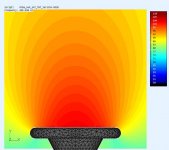 drba_swh_147_T07_Jericho_RO2b-Hfield@500Hz.jpg40 KB · Views: 83
drba_swh_147_T07_Jericho_RO2b-Hfield@500Hz.jpg40 KB · Views: 83 -
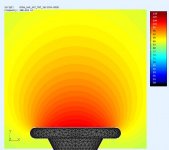 drba_swh_147_T07_Jericho_RO2b-Hfield@200Hz.jpg37.8 KB · Views: 109
drba_swh_147_T07_Jericho_RO2b-Hfield@200Hz.jpg37.8 KB · Views: 109
This is "jericho" after some modifications.
The green surface is exactly the same as before. The teal surface is an additional curve#1 to take the mouth exit from 45deg to 90deg. The grey continuation is curve #2 to create the roll over. The same scale is used in the pre/post graphs.
Making the mouth larger improves the impedance match and the round over reduces the diffraction.
!!!!!!!!!! *the biggest smiley face*!!!!!!!
Happy you like it.
I also suspect (speculate?) that a slightly elliptic shaped round over, added to the jericho's circular mouth, may help reduce the impedance oscillation further.
I also suspect (speculate?) that a slightly elliptic shaped round over, added to the jericho's circular mouth, may help reduce the impedance oscillation further.
I understand the idea to give an artist a general picture and let them use their own cognition to fill in the details, which allows their genius to flow 😉
This is a staple in the collection, the one horn that strives to do all the things that I wanted it to do performance wise.
There are still several horns I am interested in seeing, Shark 45/RA45 vs JMLC HVDiff no more than 40" wide.
And then I would really appreciate, like a "master piece" horn, like the horn that you and Docali would want to be the head piece, given, you know the pieces of the hardware, (AE 18H+>15M>Axi2050) your choice of xover point and profile.
This is a staple in the collection, the one horn that strives to do all the things that I wanted it to do performance wise.
There are still several horns I am interested in seeing, Shark 45/RA45 vs JMLC HVDiff no more than 40" wide.
And then I would really appreciate, like a "master piece" horn, like the horn that you and Docali would want to be the head piece, given, you know the pieces of the hardware, (AE 18H+>15M>Axi2050) your choice of xover point and profile.
Stunning work!
Is it an Iwata?
Horn iwata 220 and 600 profil le cleach.
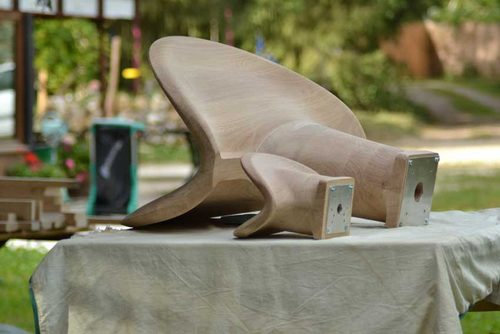
I understand the idea to give an artist a general picture and let them use their own cognition to fill in the details, which allows their genius to flow 😉
This is a staple in the collection, the one horn that strives to do all the things that I wanted it to do performance wise.
There are still several horns I am interested in seeing, Shark 45/RA45 vs JMLC HVDiff no more than 40" wide.
And then I would really appreciate, like a "master piece" horn, like the horn that you and Docali would want to be the head piece, given, you know the pieces of the hardware, (AE 18H+>15M>Axi2050) your choice of xover point and profile.
For you application it seems that only constant T horns fulfill your requirement for low loading. Btw, I have just seen here a horn claiming to load below 300 Hz and was only about 33cm long. This is highly questionable in my eyes.
Here is a similar horn where Jericho meets Shark:
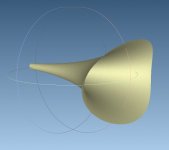
View attachment drba_SWH147_SF138_Jericho_meets_Shark.zip
Horn iwata 220 and 600 profil le cleach.

Great work!
What is the weight of one of the big horns?
Maybe some day I will come back to you with my own designs 😉
For you application it seems that only constant T horns fulfill your requirement for low loading. Btw, I have just seen here a horn claiming to load below 300 Hz and was only about 33cm long. This is highly questionable in my eyes.
Here is a similar horn where Jericho meets Shark:
View attachment 798593
View attachment 798594
To be honest, several of the horns you designed around the time of the first shark, are pretty excellent designs and considering how well the lip treatment has treated the Jericho as a truncated mouth, can only expect great things.
I think this model is a blend of several of the approaches we've tried, it looks like a contender for a 200hz xover, very excited to see how it simulates!
Speaking of Jericho horns, about 2 months ago I wrote a short review about the Danley J1s. Last week, in the same club, I was dissapointed with the muddy, undefined (sub)bass in close proximity of the 16x TH118 and 2x TH812 lined-up along the stage, below the Jericho 1's.
I attributed this to the DJ, who, at that moment played a heavy bass track, probably also with the bass knob turned all the way to the right.
Last night I went to a collective birtday party of 3 friends who had rented out a room in an alternative club. Some well known djs had to make do with 2 Behringer Eurolive tops and no subs... an abomination.
After the joint closed (only an hour after I got there) we decided to go to another place. Little did I know I was in for a bit of surprise.
It appeared, the (small) club got a Danley Pure Groove 4-point system last month, consisting of 4x SH50 and 2x TH118, complemented with MC2 Audio gear.
There are also ATC SCM45A monitors, a handmade Alpha Recordings System Model 9900 rotary mixer, a Roland Space Echo and an Avalon 747 /compressor equalizer amongst other esoteric bits of equipment in the DJ booth.
The dj (couple) played a wide variety of music: hip hop, Latin, disco, new wave, etc.
So what did the 4-point Danley system sound like? Like gigantic quadrophonic high-end headphones.
It's by far the best Danley Pure Groove system I've heard and among the best club systems I know.
However, I am still not 100% convinced I could live with (2 instead of 4) Synergies/MEHs at home.
The ultra transparent and highly directive rendition presumably takes some time getting used to, but it definitely draws you into the music.
I attributed this to the DJ, who, at that moment played a heavy bass track, probably also with the bass knob turned all the way to the right.
Last night I went to a collective birtday party of 3 friends who had rented out a room in an alternative club. Some well known djs had to make do with 2 Behringer Eurolive tops and no subs... an abomination.
After the joint closed (only an hour after I got there) we decided to go to another place. Little did I know I was in for a bit of surprise.
It appeared, the (small) club got a Danley Pure Groove 4-point system last month, consisting of 4x SH50 and 2x TH118, complemented with MC2 Audio gear.
There are also ATC SCM45A monitors, a handmade Alpha Recordings System Model 9900 rotary mixer, a Roland Space Echo and an Avalon 747 /compressor equalizer amongst other esoteric bits of equipment in the DJ booth.
The dj (couple) played a wide variety of music: hip hop, Latin, disco, new wave, etc.
So what did the 4-point Danley system sound like? Like gigantic quadrophonic high-end headphones.
It's by far the best Danley Pure Groove system I've heard and among the best club systems I know.
However, I am still not 100% convinced I could live with (2 instead of 4) Synergies/MEHs at home.
The ultra transparent and highly directive rendition presumably takes some time getting used to, but it definitely draws you into the music.
An externally hosted image should be here but it was not working when we last tested it.
An externally hosted image should be here but it was not working when we last tested it.
Last edited:
Interesting report. Thanks!
FWIW, at one point Tom offered to let me borrow a pair of SH50 to try at home and compare to my Altec rig. Tom would like the SH50 to be sold in the Hi-Fi market, but the business model currently isn't right. The loan never happened (I moved), which is too bad. From the demos I've heard, I think I would have quite liked the SH50 as home Hi-Fi.
FWIW, at one point Tom offered to let me borrow a pair of SH50 to try at home and compare to my Altec rig. Tom would like the SH50 to be sold in the Hi-Fi market, but the business model currently isn't right. The loan never happened (I moved), which is too bad. From the demos I've heard, I think I would have quite liked the SH50 as home Hi-Fi.
- Home
- Loudspeakers
- Multi-Way
- Is it possible to cover the whole spectrum, high SPL, low distortion with a 2-way?
